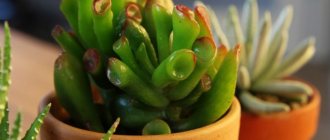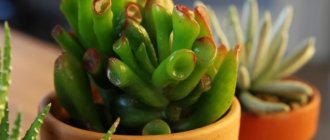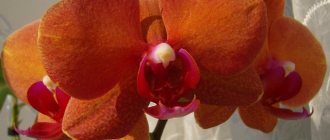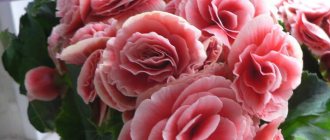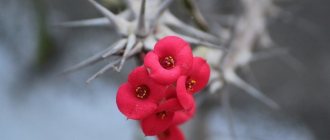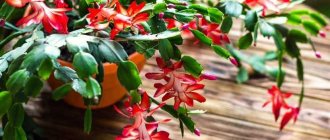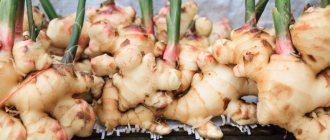The Crassula succulent plant, also called Crassula, is part of the Crassula family. According to information taken from various sources, this genus includes from 300 to 500 different species. More than 200 species are found in South Africa, and many more species can be found in Madagascar and tropical Africa. Some species can be found in the southern part of the Arabian Peninsula; this plant is widespread mainly in the Southern Hemisphere. Its name is derived from the word “crassus”, which translates as “thick”, this is due to the fact that in most species the foliage has a fleshy structure. At home, the most commonly grown species is Crassula purslane; it is also called the “tree of happiness” or “money tree”. However, many other types of Crassula are also grown indoors.
Characteristic
Crassula minor is an artificially bred variety that is a variety of Crassula ovata. The leaves of the plant are quite small - no more than 1.5 centimeters in length and 1 centimeter in width. They have an oblong shape. The coloring is very interesting, which allows it to complement any garden compositions with Crassula - the edges of the leaf above and below are framed in red, and the middle of the leaf is dark green. Depending on the lighting, the indoor plant changes its shade.
The trunk of young Crassula minor is green, fleshy and soft. Over time, when the lower leaves die, it becomes bare and woody. This property of the plant allows it to form miniature trees as it grows.
Features of Crassula
In culture, as in natural conditions, you can find Crassula represented by herbaceous and aquatic plants, tree-like shrubs, there are both very small and large succulents, but they have one common feature: on the shoot their leaf plates are placed crosswise opposite each other . Such a succulent plant, when grown indoors, has a smaller size compared to those specimens that grow in nature; the fact is that such a crassula is limited by the volume of soil mixture, space and other conditions that are necessary for active growth. However, over time, such a flower still becomes a tree with a thick stem. The leaf blades are entire and simple; in some species they are ciliated. The lateral or terminal inflorescences can be racemose or umbellate-paniculate; they include flowers of yellow, red, white or pale blue color. But it should be taken into account that in indoor conditions, the fat plant almost never blooms. This crop is very popular among gardeners due to the fact that it is unpretentious, hardy and very easy to care for.
Home care
It is impossible to grow a healthy and beautiful “money tree”, which, according to many popular beliefs, attracts financial well-being into the house without proper care for it. These are simple steps that will not take much time, but will provide the plant with the necessary nutrients and create comfortable conditions for growth.
First you need to choose the right crassula minor in the store. The health of the plant is indicated by its appearance. The leaves should be elastic, without spots and rough plaques, without damage by insects and parasites. The trunk is elastic, without flaccid areas and depressions.
Landing
After purchasing Crassula minor, it should be replanted in suitable soil. Usually they take ready-made soil for cacti or prepare the substrate themselves: 1 part peat, leaf and turf soil and 0.5 part sand. The soil must be well drained; for this, small broken bricks or charcoal are added to the pot.
The choice of the pot itself depends on the diameter of the plant crown. Crassulas prefer shallow but wide containers; their root system is small and does not need space.
The usual transplantation of Crassula minor is carried out annually in the spring using the transshipment method, preserving a piece of earthen coma at the roots.
Watering
Crassula needs specific watering. Excessive fluid intake can lead to the death of the “money tree”. The soil should be moistened only when it has dried to a depth of more than 3 centimeters.
From spring to late autumn, Crassula minor is watered once every 1-2 weeks , as soon as the soil needs it. In winter, when the plant is moved to a cool room, it needs to moisten the soil mixture only once a month.
You should not allow the earthen clod to dry out, so that the Crassula roots are not damaged. If the plant does not have enough moisture, this immediately becomes noticeable by the darkened leaves, which wrinkle and cease to shine.
Excessive moisture threatens rotting of the root system and stem.
Pruning and crown formation
Crassula minor is easy to form a crown. This allows you to make it a real decoration for your home mini-kindergarten. As soon as 3-4 pairs of leaves grow on a branch, the next bud that hatches is pinched off. At this point, 3-4 buds will again form, and the plant will begin to branch in different directions.
Long branches of the Crassula can be pruned. To do this, use a sharp knife or blade, and the cut area must be sprinkled with charcoal or crushed activated carbon.
Popular varieties
There are several varieties of indoor flowers, they differ in appearance and shape.
- Minor. This is a miniature variety - up to 30-40 cm in height, with glossy leaves pointed at the tips. Under good growing conditions, the trunk and leaves take on a reddish tone with age. With an excess of organic fertilizers, the decorative effect is lost.
- Oblikva. The variety was bred by domestic breeders. In Europe it is called lime or lemon. The main difference between the variety is the presence of stripes on the surface of the leaves, and their color can be different. The edges of all leaves are rich green. To achieve maximum decorativeness, you will need to provide two conditions - continuous lighting and coolness.
- Gollum, or hobbit. An old hybrid form, bred in the 70s by American breeders, based on the milky and ovate Crassula. The leaves are tubular and have a red edge at the end. They are narrow at the bottom, widened closer to the top. The plant is characterized by slow growth - it grows by 4-5 cm per year. The maximum height is 50 cm. The crown can be different - round, oval and completely shapeless.
- Sunset. Translated from English it means “sunset”. The leaves are bright - the main cover is emerald, with cream edges and purple edging. With a lack of light, they become a solid green color. In the wild it blooms from the beginning of March until the end of August with small flowers collected in brushes. There are specimens with yellow, blue or red tints. At home, flowering is observed extremely rarely.
- Tricolor. This is a variety of Crassula obliqua. The leaves are green with whitish stripes and a bright scarlet edge. The crown is spherical, consists of numerous shoots, densely covered with emerald foliage. The leaf blade is dense, fleshy, rounded, glossy.
- Horntree. This variety is distinguished by an unusual shape of leaves - as they grow, they curl around a central vein. The tips are reddish. In young specimens the trunk is deep pink, and with age it becomes covered with a dark brown crust.
- Variegata. A miniature plant with variegated foliage - the main color is light green, with an emerald stripe in the center. The leaves are oval with pointed tips.
Reproduction methods
Crassulas propagate by cuttings and leaves. These are the simplest methods that guarantee rooting and further growth of the plant.
The krasula leaf is torn off and placed in water for a day. Then it is transferred to a pot and covered with earth. Watering abundantly.
Propagation by cuttings is no less simple. The cuttings are separated from the plant, dried for 1-2 days and placed in a mixture of soil and sand or in a prepared mixture for cacti. The first watering is carried out after 3 days, allowing the plant to adapt a little. The next moistening of the soil is carried out as it dries.
Crassula perforata or Crassula perforata: what kind of plant is this? Description of species and their photos
In this article we will look at one of the varieties of succulent plants, of which there are from 300 to 500 species, among which you can find both small plants and some huge ones, up to several meters in length.
Crassula perforata (Crassula perforata) - (the name is from the Latin crassus - thick, which characterizes the fleshy structure of the leaves and stems) is a well-known variety of succulents with fleshy green leaves, which is a small shrub.
Diseases and pests
Crassula minor is susceptible to parasitic diseases. Its leaves are often attacked by scale insects, spider mites, aphids, and the root system is attacked by root and mealybugs, and fungus. Signs of the disease can be not only visual insects and their metabolic products on the surface of the crown, but also lethargy, rotting, and spots on the foliage.
Insecticides sold in stores will help get rid of pests. Their chemical composition is destructive to pests, but safe for the plant.
It is much more difficult to get rid of a fungus that has affected the root system. The reason for its appearance and spread may be excessive watering with cold water straight from the tap. If fungal damage is detected, the fat plant should be pulled out of the pot, the roots freed from the earthen ball, washed, treated with special antifungal agents and replanted in a new soil mixture.
Crassula minor requires human help for proper development and growth. This miniature and original plant will be a bright addition to the garden of “living stones” of succulents or will delight the eye as a single formed tree.
Description of the variegated form
Crassula ovata f. variegata cv. Hummel's Sunset (Crassula ovata Hummels Sunset variegata) is one of the varietal variations of Crassula oval. This semi-herbaceous shrub is a South African native. The species belongs to the genus Tolstyanka and the Tolstyankov family. Crassula in nature reaches a height of 180 centimeters. With good home maintenance - up to one meter. The stems are initially soft, juicy, green, then become woody and change color to brownish. Rosettes of fleshy, glossy wedge-shaped leaves on short petioles are located in abundance on the stems.
Crassula ovata is a succulent plant that accumulates water in its own tissues . This shrub blooms with small white or pink-tinged “star” flowers. Sometimes Crassula Sunset flowers are brighter (with a bias towards blue or red tones).
The name Sunset (“sunset” translated from English) poetically reflects the appearance of the variety form. A plant whose leaves harmoniously “collect” several gentle sunset tones looks very attractive. In the middle they are green, closer to the edges they become creamy yellowish in color. The edges of the leaves of the money tree are in pleasant red shades.
Crassulas are unpretentious succulents that are easy to keep at home . It is enough to follow certain simple rules, and the Sunset Crassula will successfully live on your windowsill. Crassula ovata is a long-lived perennial: growing for two and a half decades or even more is in the order of things for it.
Photo
We invite you to get acquainted with other types of this beautiful and easy-to-care plant. Read about the Tree Crassula, Purslane, Sunset, Silver, Lycopod, Perforata, Buddha Temple, as well as The Hobbit and Gollum.
Similar plants
- Crassula Hobbit . Crassula the hobbit. A variety that surprises with its intricate, pleasant appearance. The fleshy leaves seem to be rolled into tight tubes. Like Crassula ovata sunset, the leaves have a soft reddish tint at the tips.
- Crassula mix . Crassula mix. Abundantly growing shoots are decorated with elongated leaves. Along the edges of which there is a calming shade of purple. You want to admire them.
Crassula perforata. Crassula perforata (perforate). Another representative of the same family. Equally juicy, fleshy leaves. However, this time – collected in magnificent green “roses”.- Sempervivum tectorum . The roofing was rejuvenated. The famous "stone rose". This species is distinguished by a rich variety of leaf colors (the same red, green, cream tones as Sunset)
- Echeveria lilacina . Echeveria violet. Another succulent for lovers of perfect forms (a rosette of leaves in the form of a rose-shaped flower) and picturesque colors. If there is enough sun, then the leaves of echeveria can surprise with lilac, pinkish hues.
Crassula ovata sunset is an interesting variety that is definitely worth adding to your succulent collection. It is easy to care for and looks very original, colorful and attractive.
Possible difficulties
- The flower sheds its leaves from direct sunlight and excess accumulated moisture.
- Stagnation of water in the soil and a sharp drop in temperature provoke the appearance of root and stem rot. Urgent pruning, quarantine and replanting with complete soil replacement are required.
- Light coating on the leaves (powdery mildew) - high humidity, musty air, cold conditions.
- Deformation of leaves, growths, changes in color and elasticity of leaves - excess fertilizer and moisture, lack of light.
- Mealybugs and scale insects are treated with alcohol and then removed by hand.
- Spraying with phytoverm, actellik or actophyte will get rid of spider mites.
Top dressing
The flower absorbs cactus additives well. During active phases, i.e. from March to September , supplements are administered every month. If you do this more often, the fat plant will develop incorrectly , and the root system will weaken .
Fat woman loves:
- potassium – gives plants intense color;
- phosphorus – enhances growth rate, branching, flower restoration;
- nitrogen - regulates the development of the bushy part of all plants, but you cannot overdo it with it, excess can harm the development of other elements of Crassula - flowers and the root system.
You can use ready-made additives designed for cacti and succulents.
Wood ash is added as organic matter . It is used in powder form, or diluted with water to a liquid state in a 1:1 .
Varietal diversity of Crassula ovata
The money tree today offers a considerable selection of unusual varieties:
- original thick-trunked bushes of the Oblikva series with pointed lanceolate striped leaves;
- small-leaved varieties of the “Compact” series;
- miniature blushing bushes of the “Minor” variety;
- bizarre leaves of the Hobbit variety fused at the base;
- variegated variegated varieties (for example, “Tricolor”, “Sunset”).
Special varieties are becoming more and more popular. You should choose them according to your taste, because they are similar in character to the base plant.
Oval Crassula (Crassula ovata), variety “Minor”. José Leocadio Rejas Ma Crassula ovata, “Hobbit” variety. sakyurek Crassula ovata, variety “Tricolor”. gardentags
Useful tips
Any fungal diseases make themselves felt on the root parts of the plant. After some time, the fungus rapidly “spreads” over other surfaces. As a rule, under conditions of this disease, the foliage of the plant may noticeably shrink. To prevent such a problem, experts advise treating the fat plant with a solution of potassium permanganate twice a year.
You can fight the parasites that attack this succulent using various effective means. One of the highest quality and most frequently used products is Fitosporin-M. It will need to be diluted correctly (how to do this is usually indicated on the packaging). The leaves of the plant are treated with the resulting composition.
When transplanting a fat plant into a new pot, it is very important to act as carefully as possible.
The main thing you should pay attention to is caring for the roots. If you accidentally damage the rhizome system of a plant, it may not take root in its new location.
For more information about the types and varieties of Crassula, see the following video.
